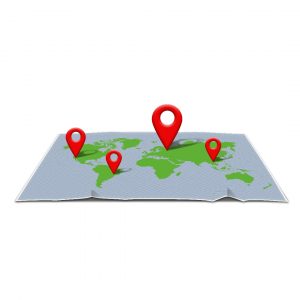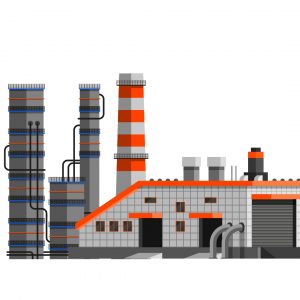Differences Between Location of Industry and Localisation of Industry: Location of industry refers to the area or place where an industry is situated. It is the geographical area where the establishment of industry or economies are set, usually because of the advantage the chosen area affords the industry in terms of resources and supply flow.

Recommended: How to speak in Public without fear
Factors Affecting Location of Industry
The major determinants of the location of an industry lies in the economic factors. Although there are other factors influencing choice of location that cannot be classified as economic factors, cost effectiveness is usually the major objective considered when making a choice for the location of industries. Some of these factors affecting location of industries are;
1. Funds: Where the funds are most concentrated, that’s where the industries are usually located. Finances are a very important factor in running an industry, and it is very common for industries to determine its location with consideration to places where money can be easily accessed.
This includes getting loans quickly and with low interest rates, and the presence of influential and wealthy persons in that location.
Recommended: Advantages and Disadvantages of Division of Labour
2. Availability of Labour: Labour is necessary for an industry to run, and an adequate and constant supply of said labour is important. Usually, labour can be made available in any place if it is sought for, but the primary thing is to not just find labour, but to find cheap labour comprising of workers who are skilled to do the tasks set.
The determinant ratio according to the ‘Labour Cost of Index’, is the cost of labour as against the total production cost.
3. Power Supply: Power and energy supply are important factors to consider when making the choice of the location of an industry. Depending on the product(s) the industry manufactures or refines as the case may be, supply of power at the cheapest it can be gotten is very essential.
Means of power supply to industries have evolved over the years. Water, wind, coal were used earlier before the introduction of gas, steam engines, electricity, etc. These latter sources of power make for more flexible energy supply to newer industries.
Recommended: Countries around the world with the highest minimum wage
4. Market Proximity: Proximity to markets for goods produced or manufactured is another factor affecting location of industries. In cases where the industry concerned produces perishable goods or goods too bulky to be transported to farther locations, nearness to markets is a non-negotiable.
By considering this factor, transportation costs will be cut down and the risk of good perishing before they get to the final consumer will be reduced. However, proximity to target markets are lot more important for industries manufacturing perishables or consumer commodities than it is for any other industry.
5. Access To Raw Materials: The goal of every well-meaning manufacturer is to cut production cost as low as possible without affecting the quality of the product, and make the maximum profit possible. One of the ways to do this, or at least to reduce production cost alone, is to ensure proximity to the source or supply of raw materials.
Being located far from the source of raw materials undeniably incurs transportation costs, as well as running the risk of raw materials perishing or being damaged in transit. This is especially so for consumables such as food products or any other agricultural-based products, as well as industries that work with wood or forestry such as Papermills, plywood industries, furniture making industries, etc.
Also see: Highest Paying Companies in the world
Meaning of Localisation of Industries
Localisation of industries refers to the concentration of industries, often of the same type, in a particular location or area. Localisation of industries is a valid topic of discourse because it generally affects the overall ratio of resources within that location and how they are shared by the industries concerned.

Localisation of industries is common because one would often find a particular community focused in producing on type of commodity, whether locally or industrially. This may also affect the market value of the common commodity within that area, and the industries may have to find market options in other locations.
Recommended: How to become a successful business woman
Factors affecting Localisation of Industries
1. Competition: When industries manufacturing the same type of products are concentrated in a particular area, competition is inevitable. Each of these industries would then have to decide if they are equipped to handle the competition and if they are willing and have the resources to keep up with it.
Also, inevitably, one industry’s products will be favored over the others, depending on reasons peculiar to the people making up the target market in question. An industry can also shoulder the tension of competition by focusing on other markets to avoid incurring losses due to poor sales.
Recommended: Countries with the Most Educated People in the World
2. Legal factors: Depending on the type of products manufactured by these industries and whether they also source their raw materials from the same place, legal issues may arise.
In some cases, boundary issues between industries or between the inhabitants of the area and industries may arise. Usually litigation cases arising from such situations are raised due to pollution or degradation of the environment of the host community due to the activities of the industries.
3. Government Incentives: Sometimes the government encourages people to set up industries in undeveloped and rural areas by implementing policies that provides incentives for industry owners. These incentives could come in form of reduced taxes and better loan offers.
The government could also place some restrictions on those who insist on locating their industries in the urban areas, making the rural areas a lot more appealing than any other location. The resulting effect is an influx of industries in rural areas which could in turn result to localisation.
Also see: Differences between growth and development
4. Raw Materials: If the industries concentrated in a particular area source their raw materials from the same area, a shortage could occur at some point. In addition the increased demand on the raw materials could make the prices skyrocket and cost of production as well as a result.
If some of the industries decide to source their raw materials elsewhere, increased transportation cost comes in, but it would reduce the demand on the raw materials and might even things out a bit.
5. Supply of Labour: Surely, every industry needs its workers, and so supply of adequate labour is pertinent. The question then becomes, will the localised industries source their labour from their host community? Are the members of the host community likely skilled in the job at hand? Would some of the localised industries have to source labour from outside the community?
The likely occurrence is that a sizeable percentage of labour required (if not all) will come from the host community. After all, one of the reasons government offers incentives for industries to be set up in undeveloped areas is to enhance development there, which includes providing job opportunities for the members of that area.

Recommended: Differences between language and dialect
Differences Between location of Industry and Localisation of Industry
Location of industry is quite simply, as the term suggests, the area or place of establishment of an industry. Location of industry focuses its spotlight on one industry and the factors that make a particular location conducive and favourable for it. Localisation of industries on the other hand, is the concentration of industries in a particular location. It could be that these industries are all run by one owner or firm, or it could be that they are run by different owners but process the same kind of product nevertheless. Whether they are in the same line of business or not, certain factors come into play when industries are localized in a particular area.
Location of industry may not have the capacity to develop that area, or provide adequate job opportunities for the host community. Localisation of industries however can do this. This is because there are a lot of industries involved here, and the result is quite inevitably, development and an increased demand for labour. Urbanization also occurs in a shorter span of time because access roads may be repaired and other establishments set up to ease the transportation experience for the industries and generally ease the life of its workers.
Location of Industry may not sufficiently offset the regional balance but localisation of industries has the capacity to do that. If industries are localised in a particular area, that area is sure to be massively developed above all other areas or regions in that state or country. While development is a welcome change, regional imbalance is an error that needs to be corrected.
In terms of effect on the environment, location of industry may not greatly affect the environment of its host area, but bringing localisation of industries into the picture changes things. Environmental pollution and degradation could be on the increase, and other nuisances such as noise pollution, traffic jams and other whiles of urbanization are very likely to occur.

Edeh Samuel Chukwuemeka, ACMC, is a lawyer and a certified mediator/conciliator in Nigeria. He is also a developer with knowledge in various programming languages. Samuel is determined to leverage his skills in technology, SEO, and legal practice to revolutionize the legal profession worldwide by creating web and mobile applications that simplify legal research. Sam is also passionate about educating and providing valuable information to people.